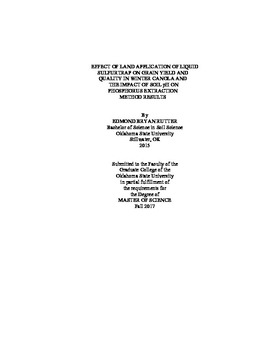| dc.contributor.advisor | Arnall, Daryl Brian | |
| dc.contributor.author | Rutter, Edmond Bryan | |
| dc.date.accessioned | 2018-06-18T17:29:51Z | |
| dc.date.available | 2018-06-18T17:29:51Z | |
| dc.date.issued | 2017-12-01 | |
| dc.identifier.uri | https://hdl.handle.net/11244/300097 | |
| dc.description.abstract | With rising production costs in both agriculture and oil and gas industries, developing management practices that are both cost effective and environmentally sound is challenging, but of great importance. Liquid Sulfur Trap is a newly patented material intended for use in midstream hydrocarbon gas desulfurization processes. Disposal via deep well injection is currently standard practice for similar oil & gas waste materials. However, spent Liquid Sulfur Trap (LST) may be useful in agricultural environments due to its high concentrations of potassium (K) and sulfur (S), which are essential plant nutrients. This study was conducted to determine the effects of land applied LST on grain yield and grain quality in winter canola. Treatments consist of variations in application rate and timing for two nutrient sources, LST and a K and S equivalent conventional fertilizer blend (PAS) comprised of potash (KCl) and ammonium sulfate ((NH4)2SO4). Field trials were set up as replicated factorials in a randomized complete block design, with a check plot receiving neither LST or PAS, and three replications per treatment. Normalized difference vegetative index (NDVI) was collected periodically during the growing season, while grain data was collected at harvest. Grain quality was determined post-harvest using near infrared spectroscopy (NIR) to analyze grain oil and protein content. The calcium carbonate equivalence (CCE) of LST was evaluated using acid-base titration and a soil incubation study. LST application reduced fall NDVI in trials at LCB and Perkins, however differences in grain yield, protein, and oil content were not statistically significant. Application timing had the strongest effect, where spring applications increased NDVI by approximately 0.075 and grain yield by approximately 350 kg ha-1 when compared to fall applications. The CCE of LST as determined by the soil incubation studies was 15.6%. The effects of LST on winter canola are difficult to assess due to wildlife grazing and poor winter survival. While the CCE of LST is relatively low, soil acidity was neutralized much more rapidly than limed soils. | |
| dc.format | application/pdf | |
| dc.language | en_US | |
| dc.rights | Copyright is held by the author who has granted the Oklahoma State University Library the non-exclusive right to share this material in its institutional repository. Contact Digital Library Services at lib-dls@okstate.edu or 405-744-9161 for the permission policy on the use, reproduction or distribution of this material. | |
| dc.title | Effect of Land Application of Liquid Sulfurtrap on Grain Yield and Quality in Winter Canola and the Impact of Soil Ph on Phosphorus Extraction Method Results | |
| dc.contributor.committeeMember | Warren, Jason G. | |
| dc.contributor.committeeMember | Zhang, Hailin | |
| osu.filename | Rutter_okstate_0664M_15377.pdf | |
| osu.accesstype | Open Access | |
| dc.description.department | Plant & Soil Sciences | |
| dc.type.genre | Thesis | |
| dc.type.material | text | |
